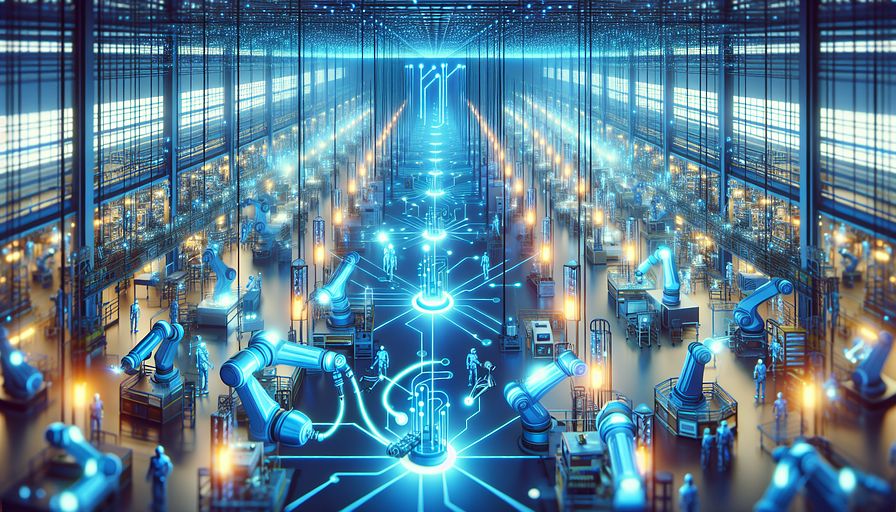Abstract:
The industrial sector is witnessing a transformative shift with the integration of robotics into factory operations, shaping the future of factory automation. This transformation is driven by the need for higher efficiency, reduced production costs, and the ability to produce complex products with precision. As robotics technology advances, we are seeing the emergence of smart factories where machines communicate and make decisions autonomously. These advancements are not only enhancing productivity but also paving the way for new possibilities in manufacturing innovation. The article explores how industrial robotics is evolving, highlighting key trends such as collaborative robots, AI integration, and the increasing use of sensors for predictive maintenance. It also examines the impact of these technologies on workforce dynamics and the challenges companies face in adopting these new systems. The future of factory automation promises significant benefits for manufacturers willing to invest in these technologies, offering a competitive edge in the global market.
The Future of Factory AutomationAs the industrial sector stands on the cusp of a new era, the integration of robotics into factory operations is not just a fleeting trend but a seismic shift shaping the future of factory automation. This transformation, driven by an insatiable thirst for higher efficiency, reduced production costs, and the art of producing complex products with unmatched precision, echoes through the corridors of manufacturing units worldwide. With advancements in robotics technology, we embark on a journey toward the era of smart factories, where machines not only chat among themselves but also make decisions with a level of autonomy that would make any science fiction writer blush. These innovations are not merely enhancing productivity; they are rewriting the rules of what is possible in manufacturing, inviting us to reimagine the boundaries of innovation. The truth is, as we peer into the horizon of factory automation, what we see is a landscape rich with potential, where collaborative robots (cobots), artificial intelligence (AI), and an intricate network of sensors for predictive maintenance are not just the protagonists of our story but are setting the stage for a revolution in manufacturing efficiency and creativity.
Let's turn our gaze to the colorful cast of characters making waves in the world of factory automation. First, we have the cobots – these are not your traditional, hulking industrial robots confined to cages; no, these are the approachable, friendly neighbors, designed to work hand in hand, or arm in arm, with human counterparts. Their emergence signifies a shift toward more collaborative and flexible manufacturing environments, where robots and humans complement each other’s strengths. Next up, AI steps into the limelight, bringing with it the kind of intelligence and learning capabilities that transform machines from mere tools to partners capable of making informed decisions. Think of AI as the brainy kid in class who, when paired with the right teammate, can solve problems in ways that were unimaginable just a decade ago. Then there’s the increasing use of sensors – the eyes and ears of the operation. These sensors don't just collect data; they predict the future. Okay, maybe not the winning lottery numbers, but close enough. They enable predictive maintenance, essentially allowing machines to say, “Hey, I think I might need a little tune-up soon,” thereby reducing downtime and maintaining the rhythm of production with the grace of a well-rehearsed orchestra.
But what does this all mean for the workforce? Are we heading toward a world where robots take over, leaving humans to reminisce about the days of manual labor? Not quite. Instead, we’re seeing a shift in workforce dynamics, where the emphasis is on upskilling and reskilling employees to work alongside these technological marvels. This transition, however, is not without its challenges. Companies face the Herculean task of integrating these new systems into their operations, a process that requires not just investment in technology but also a cultural shift within organizations. Embracing these changes, though daunting, offers manufacturers a golden ticket to a future where they can boast of efficiency, quality, and innovation that sets them apart in the global market. The road ahead may be peppered with challenges, from the need for significant capital investment to addressing cybersecurity concerns, but for those willing to navigate this complex yet thrilling terrain, the rewards promise to be substantial.
All jest aside, the future of factory automation holds immense promise for those manufacturers bold enough to embrace these technological advancements. With cobots, AI, and predictive maintenance sensors leading the charge, the horizon gleams with the prospect of significantly enhanced productivity, groundbreaking innovation, and a competitive edge sharp enough to cut through the toughest market dynamics. As we stand at the threshold of this new era, the message is clear: the future belongs to those who are ready to innovate, adapt, and rethink what's possible in manufacturing. So, while the robots may not be taking over just yet, they're certainly making a compelling case for a future where humans and machines collaborate in harmony, crafting a narrative of progress that might just be the most exciting chapter in the saga of industrial revolution yet.
You might be interested by these articles:
- Industrial Robotics Future Trends
- Next-Gen Robotics Transforming Industries
- Turning EU Regulatory Challenges into Robotics Startup Opportunities





